Mission Viejo Special, The Multiband Vertical (#5 of 6)
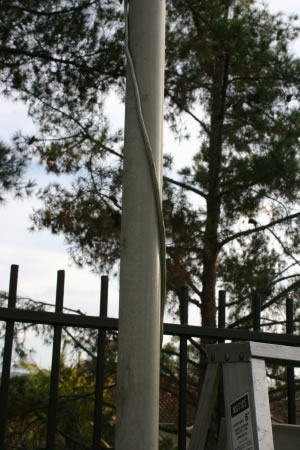
Radiation Elements – Wires
For the radiation elements, instead of bare copper wire, I am using a tinned copper braid over Dakron rope, 4.75mm OD. It is sold at thewireman.com as “Hot Rope”. Because of its thick braid elements, the element is just as good as using aluminum tubing, affording nice, wide bandwidth with low loss.
It is important that three wires do not short each other except at the feed point at the base. To achieve that, I did:
- 40 meter element is loosely wrapped around the fiber pole, to prevent it from flying around.
- 30 and 20 meter elements are hang from the top horizontal boom (see “Wire Support / Feed Point Bars”), from opposite side of each other. The tension is applied to each element using Dakron ropes via pulleys attached at each side of the support bar to keep them straight. It is convenient if it becomes necessary to re-tension the rope every now and then.
- The three wires are shorted at the bottom horizontal bar, to which a copper foil is wrapped around, then connected to the inner conductor of the feeding coax, via the SO-259 connector attached on the radial plate (see "Radial Plate").
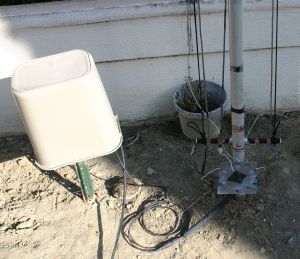
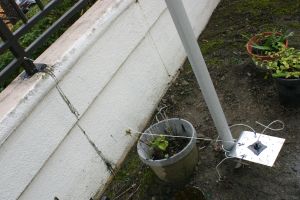
Grounding / Counterpoise
I needed a good ground for the antenna to function as a vertical ground plane. I did three things to address that issue:
- I buried a pair of 4’ copper grounding rod near the base of the antenna.
No, you won’t find 4’ rods at Home Depot. But you’ll find 8’ rods. Driving 8’ rod into the ground is a hard work. It is much easier and just as effective to cut the 8’ to half, then drive two 4’ rods.
You will also need grounding clamps (Home Depot has them) to hook up a wire to the radial plate. - I connected the wire to the wrought iron fence at the edge of my back yard, less than 3 feet away from the antenna. The fence is about 5feet tall, ~60 feet long. This is of great help.
- I buried eight pieces of about 7 meter each of 18 Ga. Copper wire under the grass, in a radial pattern surrounding the antenna.
More on those counterpoise wires. I said “counterpoise”, perhaps to distinguish from “radials”, which often means ¼ wave lengths of all frequencies involved. My counterpoise are not cut for any frequencies; just “reasonably long” copper wires. The buried depth is no more than 5 cm, just so they will not be bitten by the gardener’s lawn mower. If that is not a threat, it is not necessary to bury them.
The point is, that it is not necessary to cut exactly ¼ wave length wires for all bands to make the antenna function. It may not be 100% efficient, but it works. My scheme here seems to be working pretty well.
And, oh yes, there is a lighting arrestor connected between the antenna and the tuner, though it is not indicated in the schematics. This is always a prudent precaution.

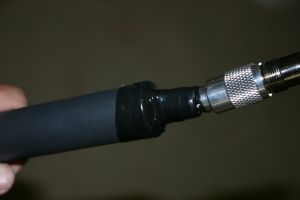
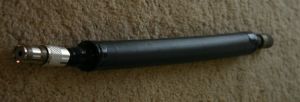
UNUN
UNUN, short for Unbalanced - Unbalanced transformer is basically an RF choke inserted at the feed point of an antenna. It adds mutual inductance between the inner and outer conductor of the coax cable, to force balancing of the ingress and egress current.
As mentioned before, for this type of antenna, it is very important to define where the feed line ends and antenna starts. An RF choke does just that. When the current through the feed line adds up to be zero, then there is no radiation from the feedline cable. So the coax feed line disappear from the matching consideration between the antenna and the transmitter.
I made the UNUN using ten ferrite beads of inner radius 12.5mm such as Amidon FB-31-1020 or FB-43-1020 ($2.00 ea at www.amidoncorp.com) through RG-8 class cable; I used RG213. For 40meter band and above, either 31 or 43 compound should give enough inductance. Though for low band HF, 31 mix may be slightly preferred, I used beads in 43 compound. That's only because I had them in stock. I then cover them with heat shrink tubing to mechanically fix the beads, and also weatherizing the device. I also use silicon sealing tape to seal each end.
This is attached between the center coax connector on the radial plate, and the antenna tuner (or the feed line from the shack if you do not have the tuner).
Be careful how you place it, as an UNUN can get hot during transmission when your antenna match is not good.
| Ü | Introduction | Þ | |
| Specification | |||
| Theory | |||
| Mast, Base | Radial Plate | Boom | Elements |
| Grounding | UNUN | Tuner | Adjustment |
| On The Air | |||